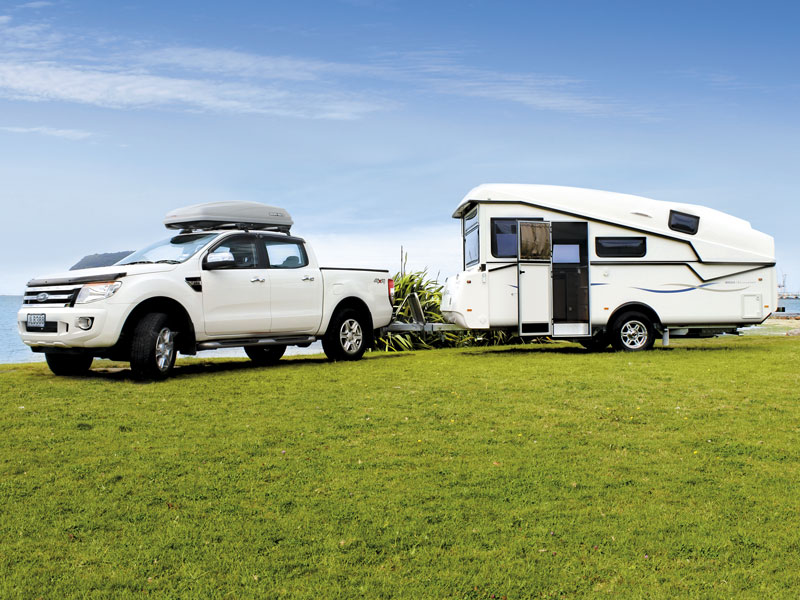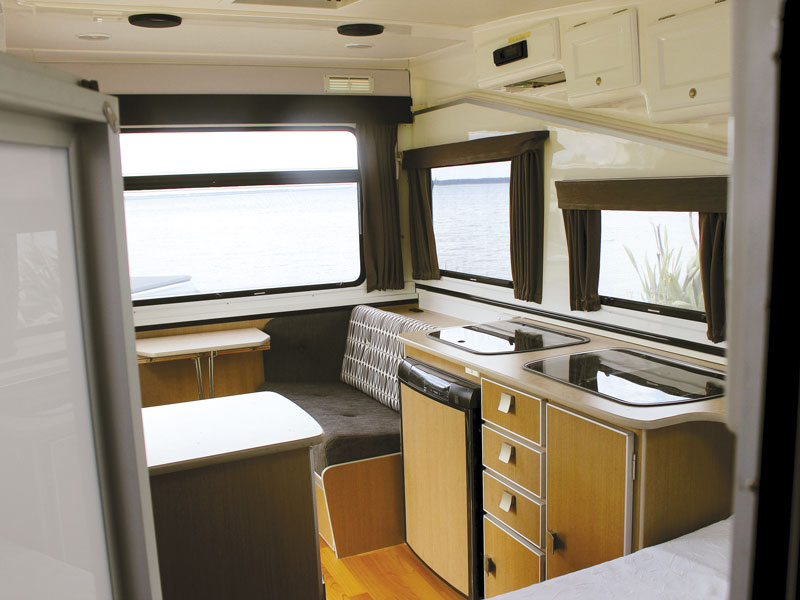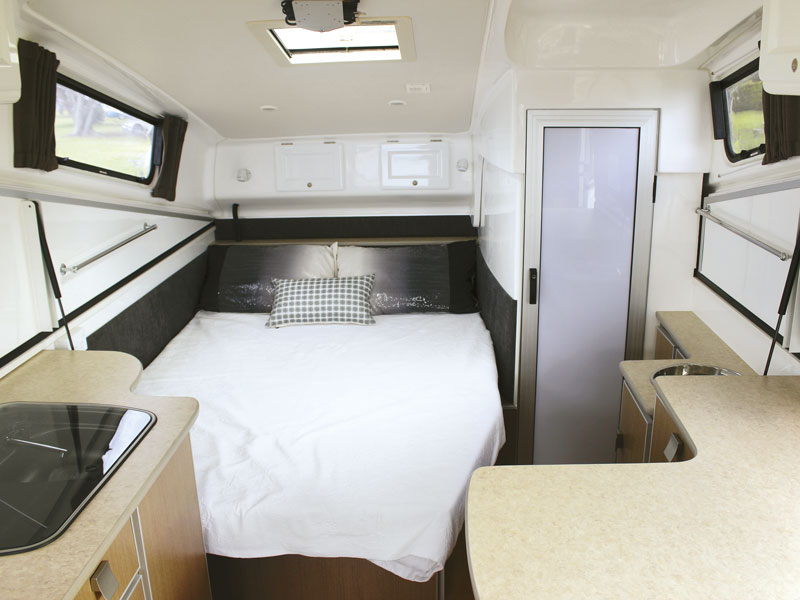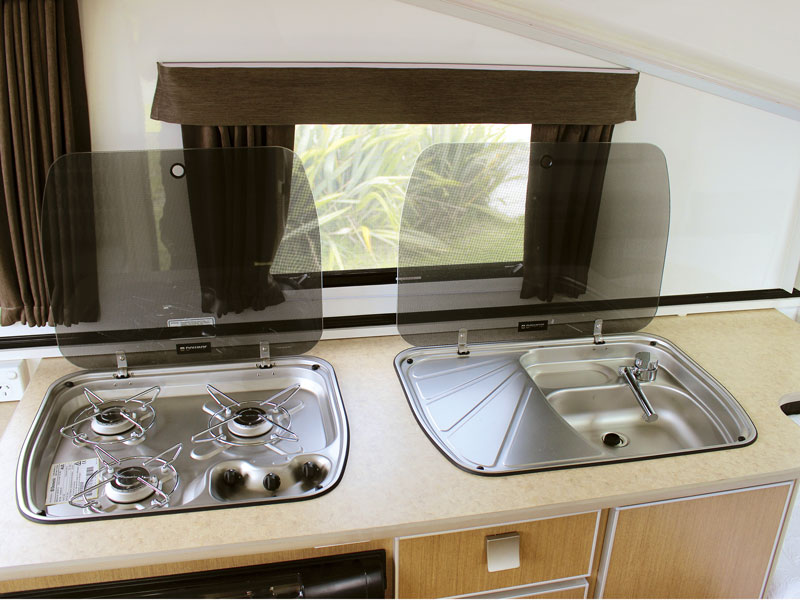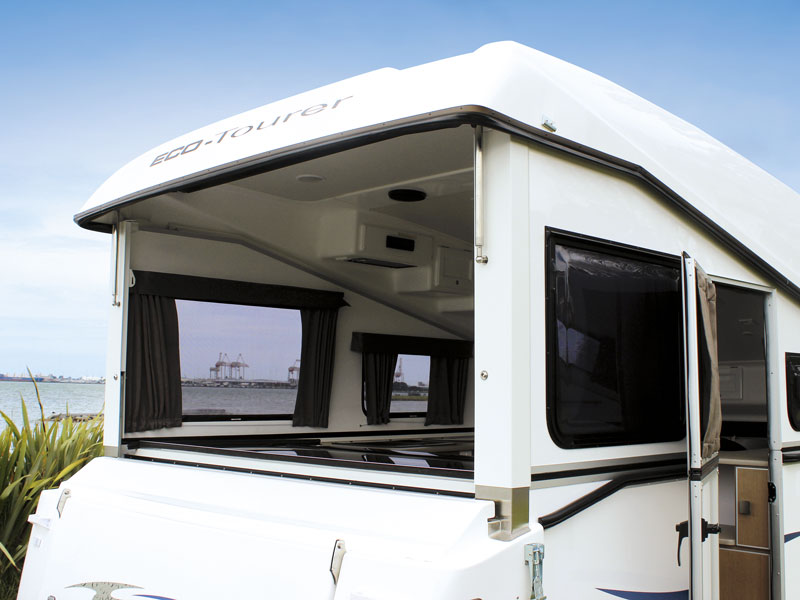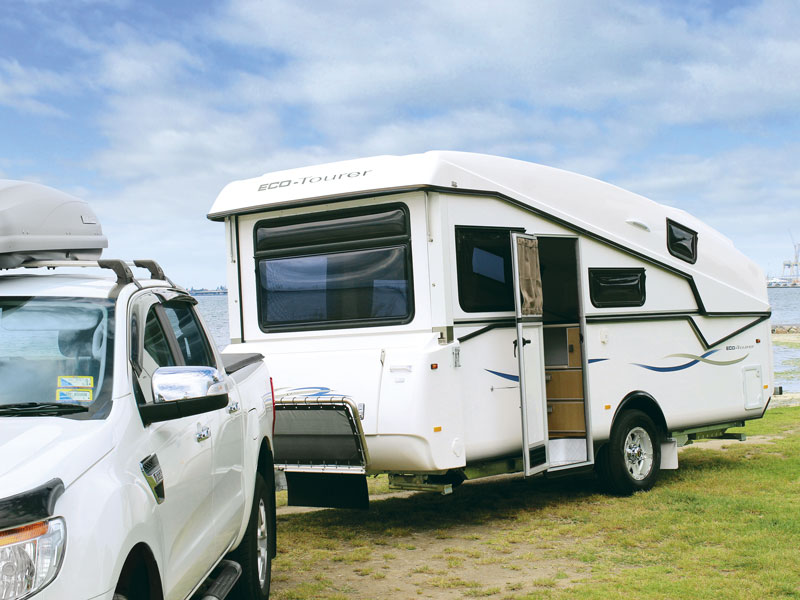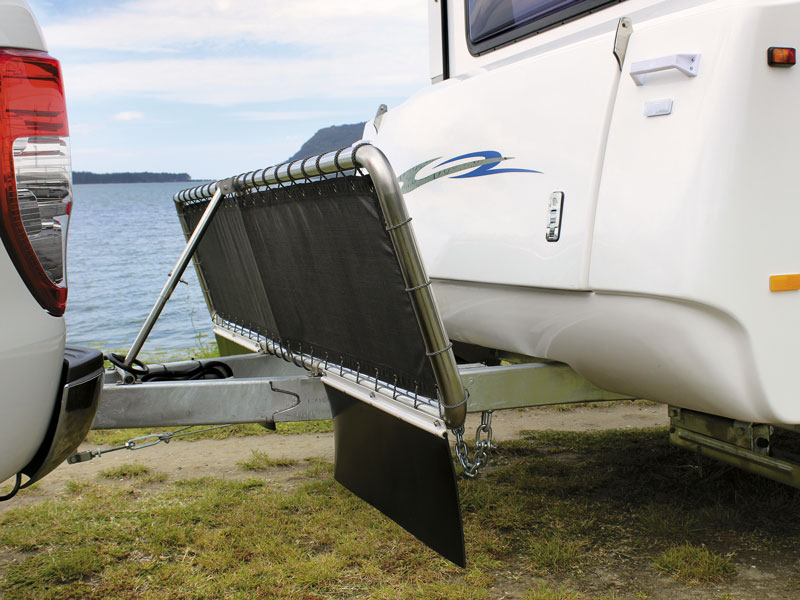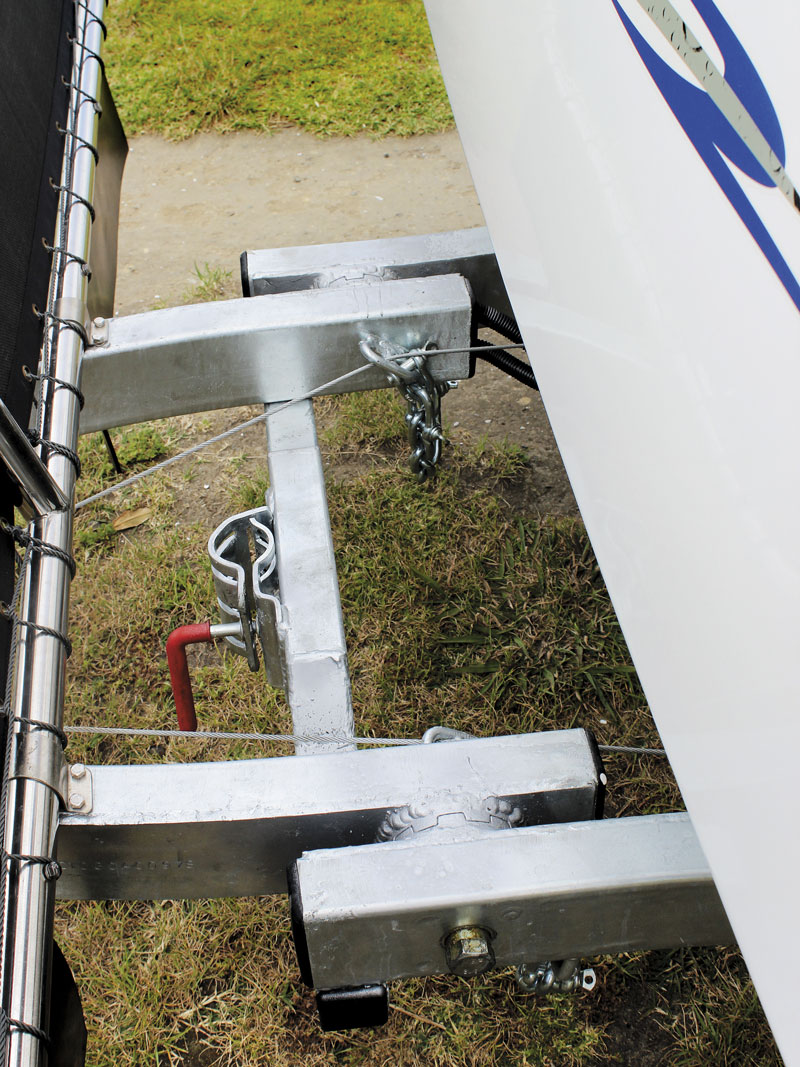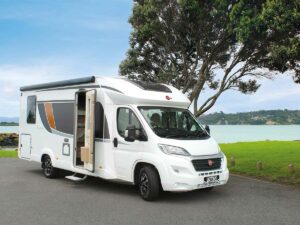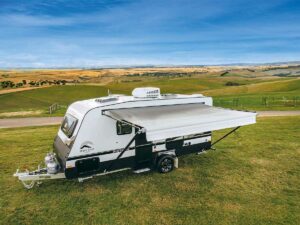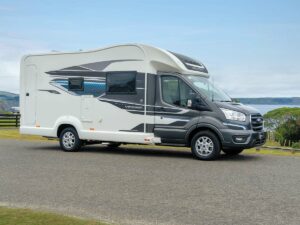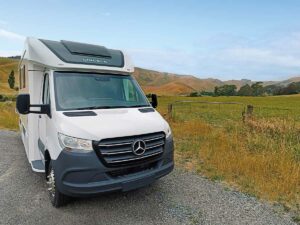It is the mark of a timeless design when the blueprint for a caravan essentially stays the same over several years yet customers remain consistent fans of the original.
That is certainly the case with the Eco Tourer; the aerodynamically-styled four berth caravan that features a fold-down section and a transit height between 2060mm and 2210mm—around two-thirds that of an average single-axle caravan boasting similar dimensions.
Mal and Alisha at Mount Maunganui-based On the Way RV have been distributing the Australian-built Eco Tourer for around nine years now.
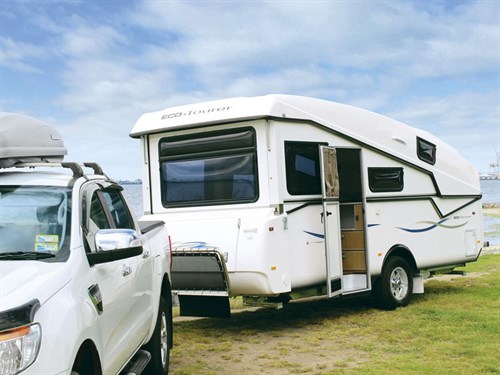 From a towing point of view, the Eco Tourer has been engineered with optimum weight distribution at the forefront of its clever design.
In the latest models, the axle has been brought slightly forward to help reduce weight on the tow ball.
Once the roof is in its lowered transit position, the caravan is incredibly stable to tow on the open road.
What's more, while you still won't be able to see over the roof of it in your rear-vision mirrors, motorists behind you can. They are not faced with a wall, which they must pull further towards the centreline to see around and decide whether they want to overtake. That is a pretty convincing safety asset out on the busy summer roads.
From a towing point of view, the Eco Tourer has been engineered with optimum weight distribution at the forefront of its clever design.
In the latest models, the axle has been brought slightly forward to help reduce weight on the tow ball.
Once the roof is in its lowered transit position, the caravan is incredibly stable to tow on the open road.
What's more, while you still won't be able to see over the roof of it in your rear-vision mirrors, motorists behind you can. They are not faced with a wall, which they must pull further towards the centreline to see around and decide whether they want to overtake. That is a pretty convincing safety asset out on the busy summer roads.
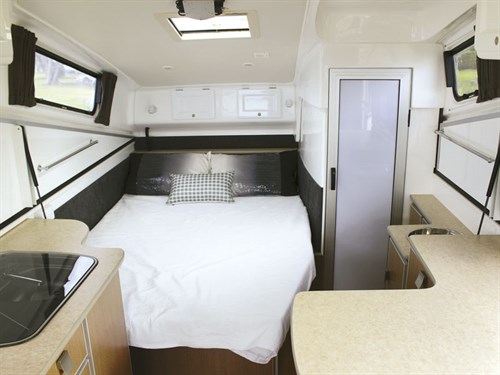 Outside, the Eco Tourer features galvanised chassis construction, a wide-track axle, external garage lockers, a twin four kg gas bottle side locker, fully insulated sides and roof, and a standard roll-out Fiamma side awning.
Inside, the latest model features freshly updated décor (with three choices of seat fabric colour), stove top and sink with separate glass lids, a 90-litre Dometic fridge, inbuilt audio system, a microwave oven, a 19" flat-screen TV including special adjustable bracket to ensure the screen can be stowed flush when the roof is lowered, a fold-out dining table, and plenty of storage options too.
Outside, the Eco Tourer features galvanised chassis construction, a wide-track axle, external garage lockers, a twin four kg gas bottle side locker, fully insulated sides and roof, and a standard roll-out Fiamma side awning.
Inside, the latest model features freshly updated décor (with three choices of seat fabric colour), stove top and sink with separate glass lids, a 90-litre Dometic fridge, inbuilt audio system, a microwave oven, a 19" flat-screen TV including special adjustable bracket to ensure the screen can be stowed flush when the roof is lowered, a fold-out dining table, and plenty of storage options too.
Exterior
The Eco Tourer pulls off a rather neat trick. Its one-piece shell is solidly constructed and features all the cosy weatherproofing attributes you' would hope for in a modern caravan. Yet raising or lowering its walls and roof section doesn't take superhuman strength at all.The caravan arrives with a manual crank handle, which is inserted into a socket at the front of the body. Mal tells me a special drill attachment can be purchased to speed the process up but after raising and lowering the roof four or five times, he says most people don't bother with the drill because the process—even manually—is quick. Indeed, it would take about 20 to 30 seconds to go from fully up to fully down. A few checks are required. You'll need to clear the caravan's benches and ensure the side entry door is closed beforehand. But once underway, gas struts inside the shell load up and the roof comes down silently and gently while the walls fold in a similar fashion. You can literally manoeuver the crank handle with your fingertips. From a towing point of view, the Eco Tourer has been engineered with optimum weight distribution at the forefront of its clever design.
In the latest models, the axle has been brought slightly forward to help reduce weight on the tow ball.
Once the roof is in its lowered transit position, the caravan is incredibly stable to tow on the open road.
What's more, while you still won't be able to see over the roof of it in your rear-vision mirrors, motorists behind you can. They are not faced with a wall, which they must pull further towards the centreline to see around and decide whether they want to overtake. That is a pretty convincing safety asset out on the busy summer roads.
From a towing point of view, the Eco Tourer has been engineered with optimum weight distribution at the forefront of its clever design.
In the latest models, the axle has been brought slightly forward to help reduce weight on the tow ball.
Once the roof is in its lowered transit position, the caravan is incredibly stable to tow on the open road.
What's more, while you still won't be able to see over the roof of it in your rear-vision mirrors, motorists behind you can. They are not faced with a wall, which they must pull further towards the centreline to see around and decide whether they want to overtake. That is a pretty convincing safety asset out on the busy summer roads.
Hybrid drive
Alisha and Mal say that the Hybrid model Eco Tourer has proven a good middle ground for a variety of customers. It has nothing to do with an alternative power source. The Hybrid model is essentially part way between the standard model and the full Aussie-spec Off-road Eco Tourer. As you would expect, the Off-road model features a deeper chassis and different suspension, with an associated increase in tare weight (1808kg versus 1626kg of the Hybrid). Because of that uprated suspension, the Off-road model sits taller in transit mode too, although only by 150mm. The internal and external measurements of both the Hybrid and Off-road are lineball. The Eco Tourer pictured is the Standard Eco Tourer, which sits on 15" wheels instead of the 16" and 17" alloys on the Hybrid and Offroad models. All three can be configured with a double French bed or (if you're willing to dispense with on-board bathroom facilities) with an island double or twin singles instead. Mal says that with self-containment such a big part of camping these days though, the Hybrid model with the double French bed arrangement and bathroom is a great catch-all.Full-on feature set
It might be the smallest space in the Eco Tourer but the bathroom is pretty clever. After entering through the side door, the bathroom is tucked into a nook towards the rear of the caravan alongside the double bed. You step down once to the door of the bathroom (a wet area containing over-shower and cassette toilet with a wash basin outside the door) and then you step down again inside the bathroom itself. You walk in thinking you are going to have to stoop to shower, but as a six-footer, I could stand in the bathroom and not have my head touch the ceiling. It is deceptively clever. It is this detail and the way all the overhead cubbies are moulded into the shell of the caravan that reminds you of the Eco Tourer's almost nautical design blueprint. Outside, the Eco Tourer features galvanised chassis construction, a wide-track axle, external garage lockers, a twin four kg gas bottle side locker, fully insulated sides and roof, and a standard roll-out Fiamma side awning.
Inside, the latest model features freshly updated décor (with three choices of seat fabric colour), stove top and sink with separate glass lids, a 90-litre Dometic fridge, inbuilt audio system, a microwave oven, a 19" flat-screen TV including special adjustable bracket to ensure the screen can be stowed flush when the roof is lowered, a fold-out dining table, and plenty of storage options too.
Outside, the Eco Tourer features galvanised chassis construction, a wide-track axle, external garage lockers, a twin four kg gas bottle side locker, fully insulated sides and roof, and a standard roll-out Fiamma side awning.
Inside, the latest model features freshly updated décor (with three choices of seat fabric colour), stove top and sink with separate glass lids, a 90-litre Dometic fridge, inbuilt audio system, a microwave oven, a 19" flat-screen TV including special adjustable bracket to ensure the screen can be stowed flush when the roof is lowered, a fold-out dining table, and plenty of storage options too.
Storage
Mal tells me one of the key selling points for the Eco Tourer is that, with the roof in its travel position, it can fit inside most standard garages. That is a significant bonus for anyone wanting to keep their caravan out of the elements when not touring. Before you start querying the depth of the average garage, it is not only the Eco Tourer's roof that performs the magic folding trick. The caravan's drawbar is also designed to tilt up at a 90-degree angle when not in use, saving almost a full metre in overall length and meaning the roller door can be lowered all the way down.Verdict
The Eco Tourer is an impressive caravan option; the first of its kind I have seen up close. Featuring solid construction, clever engineering, and packaging and a unique selling point in its fold-down roof and folding drawbar, which both make it easier to store when you are back at home dreaming of your next journey, the Eco Tourer is a caravan with a real difference and a whole heap of character too. There are special On the Way RV customers who have spent more than 700 nights in their Eco Tourer. And that seems indicative of the Eco Tourer buyer. Once they've holidayed in one, they never want to go away in anything else.Plus
- Unique design and construction
- Lightweight operation of folding roof/walls
- Ability to store out of the elements in a garage
Minus
- Bathroom 'wet room' won't be to everyone's tastes
- Third and fourth berth spaces are narrow (so better as a two-berth caravan)

